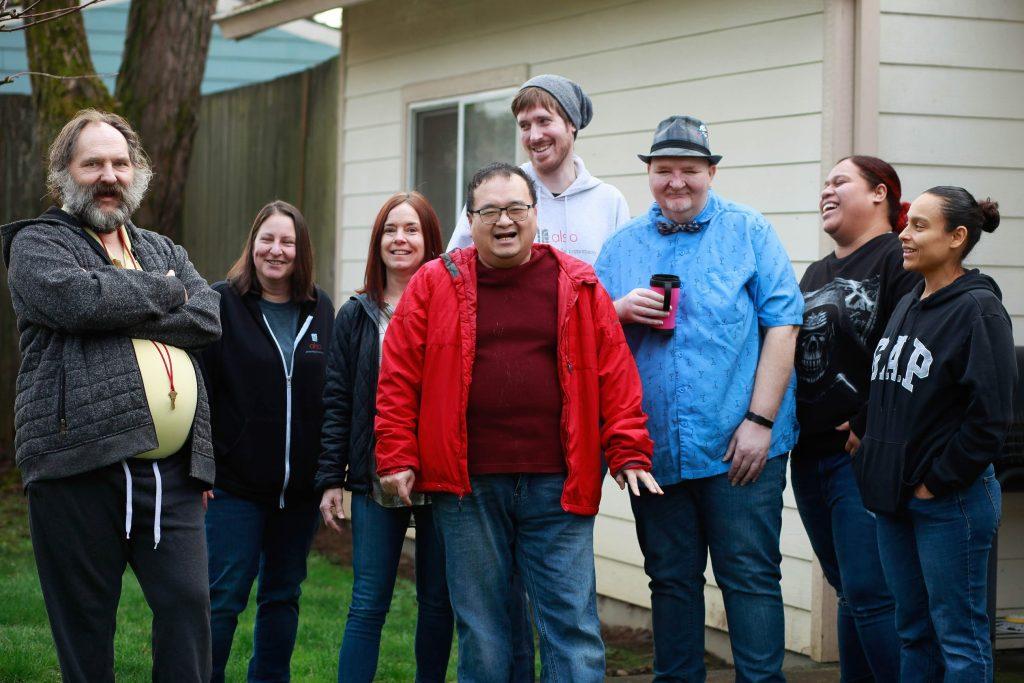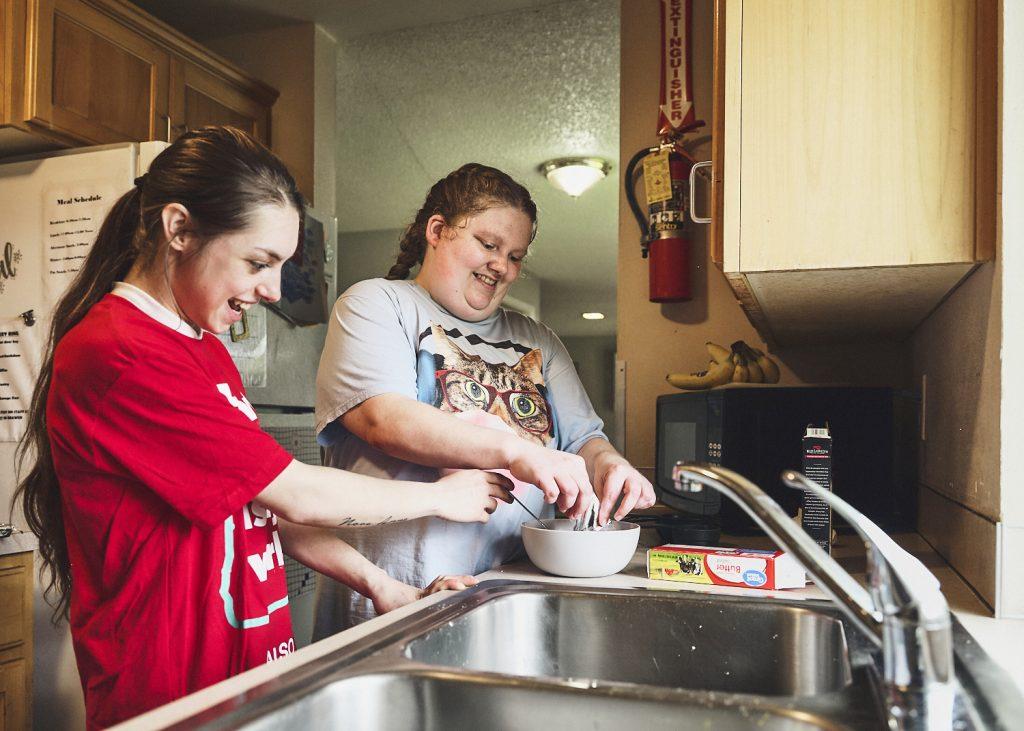Explore the ALSO Children’s Homes Wishlist and help fill the season with joy for the children supported by ALSO.
Explore the ALSO Children’s Homes Wishlist and help fill the season with joy for the children supported by ALSO.

Imagine, as an adult, living with 30 other people, people you did not choose to live with. Being instructed when to get up, when to go to bed, and when you could change your clothes. Showering with a crowd.
Then go further if you can. Imagine being told what your job would be for the rest of your life. Having to fight for your food. Not being able to lock your bedroom door. Being sterilized against your will.
That was Debbie’s life when she lived at Fairview Training Center (also called Oregon Fairview Home), which housed thousands of people with intellectual and developmental disabilities (I/DD) during its history. ALSO’s CEO Brett Turner, who’s worked in the field since 1989, met Debbie and heard her story soon after she was released from Fairview. And as bad as Debbie’s life at Fairview was, some had it worse. “People who couldn’t use words were often the most vulnerable, and sometimes fought back the only way they could,” said Brett. “If someone were stealing their food, for example, they might bite them. And then the institution would remove their teeth.”
When Fairview survivor Laddie Read was interviewed for the Oregon Public Broadcasting documentary, In the Shadow of Fairview, he described his life at the institution succinctly: “It was hell.”
Fairview Training Center is now closed, and today Oregon has no state-run institutions. However, thirty-nine states still do.
To fully recognize the effects of deinstitutionalization, we must understand the history of institutionalization: what it was, why people were institutionalized, and who those people were. The history of Fairview Training Center provides an account of that past.
Originally opened in 1907 as Oregon State Institution for the Feeble-Minded, Fairview Training Center was situated on a large “campus” where people lived in big buildings with other people like them, who were called “inmates” for much of the institution’s history. Most came to Fairview as children, even infants, and lived their entire lives at Fairview. Some were able to leave, but only if they had families willing to take them, and if they were sterilized. Many who stayed, like Debbie, were also sterilized against their will. Oregon’s eugenics law wasn’t repealed until 1983.
Conditions could be inhumane. Survivors told stories of being locked in large cages, hit with razor strops, burned with scalding water, and being shackled to concrete blocks they had to push up and down halls as punishment. Many were medicated, sometime overly so. Linda Gheer, another survivor interviewed in OPB’s documentary, said, “They gave me a lot of medicine, I could not do anything.”
You might ask why any parent place their child in such a place. “After World War II in the early ’50s, you increasingly had physicians who would tell parents to put their children almost immediately in institutions after they were born if they had an apparent disability,” said James Trent, a professor at Gordon College and author of Inventing the Feeble Mind: A History of Intellectual Disability in the United States. He states, “Most physicians would tell them for the good of the other children in the family, for the good of the stability of the family.”
“The doctor suggested the parents send them off, citing the amazing care the institutions would give them; that it was the best way to care for their child,” Brett Turner said, “And then those children became wards of the state.”
The first child admitted to Fairview was Jack Crawford, who had epilepsy. Other early residents were transfers from the Oregon State Hospital for the Insane, which housed many people with disabilities, including children as young as four years old. “It’s very important to understand that the Oregon State Hospital had many, many functions, and there were people there with conditions that today we would never associate with psychiatric care,” said Western Oregon University’s Professor Kimberly Jenson in the OPB documentary. “The definition of mental illness was very vague, People who were considered ‘different’ could often be committed to the state hospital.” Then they would be transferred to Fairview Training Center. “When I started here, twenty-nine years ago,” Fairview Operations/Security Manager Dave Fischer said in 2000, “many of the residents were not what we would consider disabled now.”
Some probably weren’t disabled at all. The majority of the children were from poor immigrant families. “I remember meeting three siblings,” said Mary Lee Fay, former director of the Oregon Developmental Disabilities Office said in an interview in the OPB documentary. She states, “I’m not sure any of them had a disability, but they were poor. Their mom died and they were never really educated so people assumed they didn’t have a lot of mental capacity, and they were sent to Fairview.”
In 1985, conditions at Fairview Training Center were so bad that a U.S. Justice Department investigation determined residents faced life-threatening conditions. Medicaid funding was subsequently cut until improvements were made in staffing and other safety issues.
In 1999, the U.S. Supreme Court made a decision on Olmstead v. LC, ruling that the American with Disabilities Act of 1990 prohibits the unnecessary segregation of people with disabilities, who have a right to live and receive services in the most integrated setting appropriate.
Those two blows began the demise of Fairview Training Center, but in the end, it may have been financial realities that sounded the institution’s death knell. In the 1980s, the costs of keeping Fairview afloat soared as the number of residents dwindled. By the 1990’s, over 3000 people with I/DD in the community were waitlisted for services while thirty percent of the state’s Developmental Disability budget went to the three percent residing at Fairview. James Toews, Assistant Administrator for the Office of Developmental Disability Services, acknowledged, “A significant portion of the plan is driven by cost.” Fairview Training Center was finally closed on March 1, 2000.
“I felt good when I got to leave,” Fairview survivor Ruth Morris said in the OPB Documentary. “Now I can do everything by myself.”
“I was very happy to get out of Fairview,” said Linda Gheer. “It was like a whole new world opened up to me.”
Debbie’s world opened up, too. She had a relationship with her family. She enjoyed going to a day vocational program. Best of all, she lived in her own space, an apartment—technically a group home with support services—but by herself, with no roommate and the ability to choose how to live her life.
Unfortunately, most U.S. states still support large institutions, keeping some people with I/DD from the life they could have. In Part Two of this series, we’ll explore the current state of deinstitutionalization and institutionalization of people with I/DD.

Oregonians with intellectual and developmental disabilities today lead very different lives than Fairview residents did. At ALSO, we’re proud to provide the supported living services and residential services that enable people with I/DD to enjoy independent lives in the community. We work with each person to create a unique and individualized plan that reflects their choices, and we support those choices with services, employment opportunities, and community-based housing. We help people to live, work, and thrive in the communities of their choice. and support independence, choice, and community for people with intellectual and developmental disabilities.

Sign up for our newsletter to get our latest news, content, and job opportunities.
Help us ensure that everyone has the same opportunities in their home, workplace and community. Let’s make dreams!
